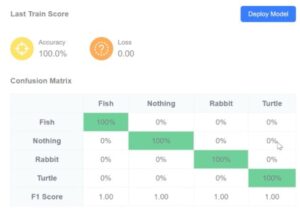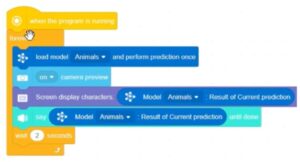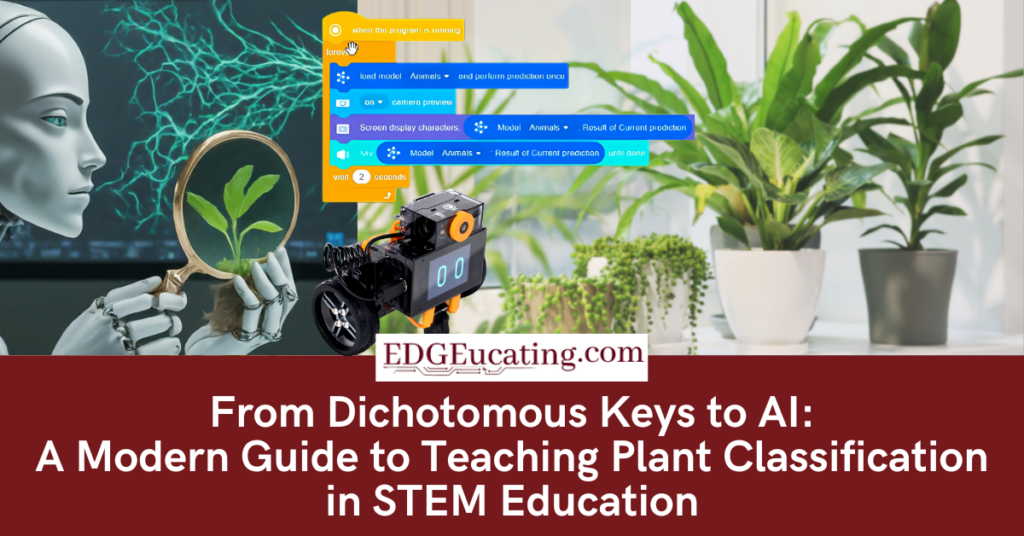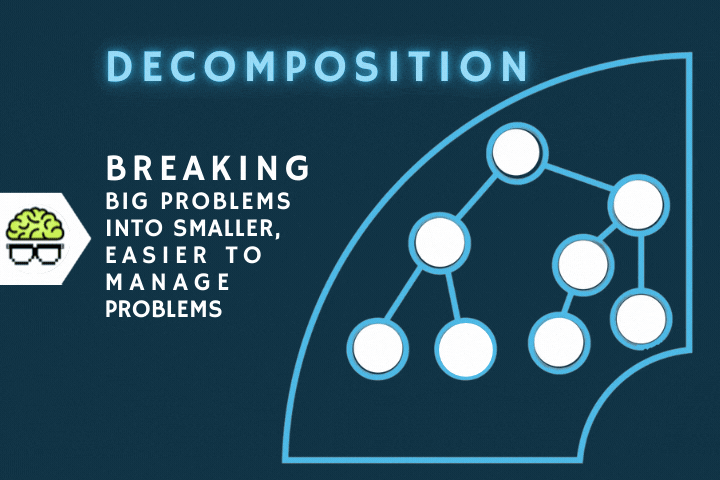Plant identification has long been a fascinating and essential part of ecological studies, connecting students to the natural world while fostering critical thinking and observation skills. Traditionally, tools like dichotomous keys have helped students unravel the complexities of plant classification, aligning seamlessly with NGSS standards. However, as we move further into the 21st century, it’s crucial to integrate emerging technologies, like artificial intelligence (AI), into these learning experiences. By doing so, we not only prepare students for the future but also inspire innovative problem-solving approaches that merge science and technology. In this context, artificial intelligence in education becomes a powerful way to transform traditional lessons into interactive, future-ready learning.
From Dichotomous Keys to Neural Networks
Let’s dive in and explore how educators can combine the age-old practice of plant identification with cutting-edge AI tools, such as Nous Coding by Matatastudio, to create an engaging, project-based learning experience. Through this modern approach, students will develop computational thinking skills, gain hands-on experience with machine learning, and grapple with the ethical implications of AI—all while fostering a deeper appreciation for the natural world. When applied thoughtfully, artificial intelligence in education allows teachers to bridge scientific exploration with digital innovation in meaningful ways.
As a 4th or 5th-grade science teacher, you have probably used dichotomous keys to help your students develop a model to analyze data and understand the relationships between organisms and their ecosystems. This work can help support the following NGSS standards:
- 4-LS1-1: From Molecules to Organisms: Construct and interpret a model to represent the cycling of matter, including the flow of energy through ecosystems.
- 5-LS2-1: Ecosystem Dynamics: Develop a model to represent the cycling of matter and flow of energy among organisms in an ecosystem.
*image created by Google Gemini
Both plant identification with dichotomous keys and AI’s (Artificial Intelligence)neural networks involve classifying objects based on specific characteristics. However, the approaches differ in their underlying mechanisms.
- Dichotomous keys: Use a series of yes/no questions to narrow down the possibilities. This is a (binary) rule-based approach.
- Neural networks: Learn from data and identify patterns. This is a data-driven approach.
Artificial Intelligence (AI) is rapidly changing the world around us. From self-driving cars to virtual assistants to chat-bots, AI is becoming increasingly integrated into our everyday lives. Thus, it is essential that as educators, we integrate these topics and concepts into our everyday learning experiences with students. This is where artificial intelligence in education ensures that students are not only consumers of technology but also creators and problem-solvers.
Thus…comes the need for Nous Coding by Matatastudio. Nous Coding is a powerful tool that makes it easy for teachers and students to learn and experiment with how AI works. The platform provides a student-friendly, block-based coding platform in which students can write code, train models, and create interactive prototypes that are powered by AI. By embedding artificial intelligence in education through tools like Nous Coding, classrooms can make abstract concepts like neural networks both tangible and exciting.
We will use computational thinking to help frame our unit with students. The following unit could be broken down into the activities listed below.
Computational Problem: How can we make plant identification more efficient for scientists?
Lesson Objectives:
- Students will understand the basics of machine learning and neural networks.
- Students will be able to train a neural network to identify two different types of plants (ie: cucumber plant and blueberry plant)
- Students will discuss the ethical implications of using AI in plant identification.
Decomposition:
(Decompose the problem) – Guide students through the process of decomposing the problem into “buckets’ similar to those below. You could have them put ideas on sticky notes and then have them move those notes around, grouping them according to categories.
- Introduction to Plant Identification:
- Review key plant characteristics (e.g., leaves, stems, flowers).
- Discuss the importance of plant identification in ecology and conservation.
- Review how a dichotomous key works.
- Machine Learning Basics:
- Explain machine learning as a way to teach computers to learn from data.
- Use a simple example (e.g., teaching a computer to recognize cats and dogs) to illustrate the concept.
- Neural Networks:
- Introduce neural networks as a type of machine learning algorithm.
- Use a simplified analogy (e.g., a brain) to explain how neural networks work.
- Plant Image Dataset:
- Provide students with a dataset of plant images (e.g., from online resources or local botanical gardens).
- Discuss the importance of data quality and diversity.
- Training the Neural Network:
- Guide students through the process of training the neural network using the Nous Coding platform.
- Explain how the network learns to identify patterns in the images.
- Testing the Model:
- Use a separate set of images to test the model’s accuracy.
- Discuss the factors that can affect the model’s performance.
- Ethical Considerations:
- Discuss the potential ethical implications of using AI for plant identification.
- Consider questions such as:
- Could AI be used to harm plants or ecosystems?
- How can we ensure that AI is used fairly and equitably?

Data and Abstraction:
Data on plants, trees, or even leaves can be found by searching on the internet. For example, here is a free homeschool resource with plant cards that can be printed out. Keep in mind that for this example, we would limit our training data to cucumber plants and blueberry plants. For the purposes of making connections to the training videos educators have available, we will continue on with examples of animals rather than plants.
Using the Nous Coding platform, you want to go to their ‘AI’ icon on the top menu bar and select an ‘Image Model.’ You will be creating ‘a new image classification training project.’
Once your project is set up, you can begin capturing your images as training data. This will be your ‘Acquisition Data.’ Use the robot’s camera to capture various images of cucumber and blueberry plants (or any other type of data you want to work with). You will need to identify each image as a ‘class.’ I suggest you watch the training video ‘05 Nous Knows Animals.’ This video will explain how to set up your ‘classes’ and put in your training data.
 Look through your training data for patterns. In the case of the data below, the patterns show that there was 100% accuracy. The abstracted ‘main idea’ is that this training model can now be deployed to see how well it can identify these animals when presented with an image.
Look through your training data for patterns. In the case of the data below, the patterns show that there was 100% accuracy. The abstracted ‘main idea’ is that this training model can now be deployed to see how well it can identify these animals when presented with an image.
Algorithm:
Finally, guide students in creating the algorithm that will deploy the model. Below is the algorithm for the animals training model. Students can now put images in front of the Nous camera, and it will run an algorithm that will predict what animal it is being shown.
 Bridging the Gap
Bridging the Gap
As educators, we must begin making these shifts in thinking so that the students will understand how our world works! It can be a huge learning experience and curve for educators, as this is content we have never been taught before.
Bridging the gap between traditional scientific practices and modern technology can seem daunting, but it opens up an exciting realm of possibilities for educators and students. By introducing tools like Nous into the classroom, teachers empower students to approach plant identification—and broader scientific challenges—with a fresh perspective. Students not only learn how to classify plants more efficiently but also gain insights into the transformative power of AI in solving real-world problems. Ultimately, artificial intelligence in education prepares learners to connect scientific knowledge with the digital skills needed for the future workforce.
At EDGEucating, we’re passionate about equipping educators with the resources, tools, and strategies needed to create dynamic, future-ready classrooms. Whether you’re teaching plant classification or exploring the broader implications of AI, we’re here to support you every step of the way. Let’s work together to inspire curiosity, foster innovation, and nurture a lifelong love of learning in today’s students.




